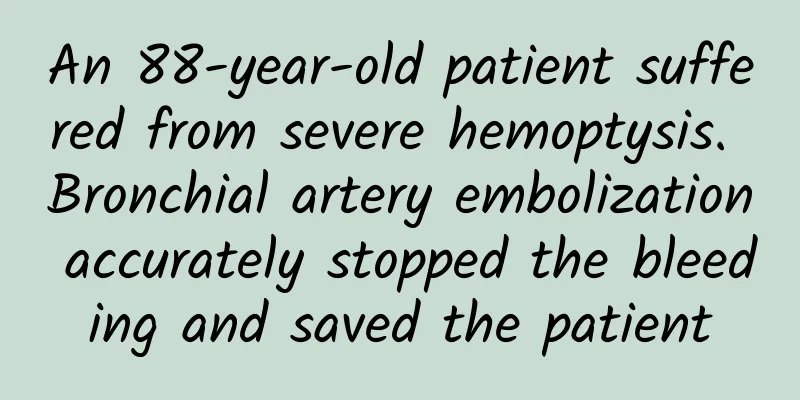An 88-year-old patient suffered from severe hemoptysis. Bronchial artery embolization accurately stopped the bleeding and saved the patient

|
A month ago, 88-year-old Grandpa Liu was rushed to the Cancer Center of Changde Second People's Hospital for treatment due to sudden hemoptysis caused by squamous cell lung cancer. According to his family, Grandpa Liu suddenly coughed without obvious signs and then had persistent hemoptysis. His condition was critical, so his family immediately sent him to the emergency room. Faced with the patient's emergency situation, the doctor immediately took anti-infection treatment measures, but Grandpa Liu's hemoptysis symptoms continued to recur and his condition was serious, so the doctor issued a critical illness notice. Grandpa Liu's daughter recalled in tears: "At the worst time, my father coughed up blood as many as 6 to 7 times a day." On the hospital bed, Grandpa Liu looked pale, weak and depressed; while his daughter sat in the corridor with red and swollen eyes, silently looking at her father with full of worry. Faced with this complex and urgent case, the Cancer Center quickly organized a multidisciplinary team consultation. Zhong Long, director of the Department of Medical Imaging and Interventional Medicine, suggested immediate implementation of bronchial artery angiography and embolization hemostasis treatment. During the operation, angiography revealed that the left bronchial artery was significantly thickened, and tumor staining and abnormal blood vessels were visible. Then, precise local perfusion chemotherapy and embolization were performed on the target blood vessels, successfully blocking the bleeding blood vessels, and Grandpa Liu's hemoptysis symptoms were immediately effectively controlled. After the operation, Grandpa Liu returned to the ward safely. After observation, the symptoms of hemoptysis were significantly alleviated, the hemoglobin level increased day by day, and finally the hemoptysis stopped completely. When he was discharged from the hospital, Grandpa Liu's family expressed their deep gratitude to the doctors. They said excitedly: "Now, Dad's symptoms are not only under effective control, but we are also relieved that at the age of 88, he can still enjoy a high quality of life and even take care of his small vegetable garden at home. This treatment not only stabilized Dad's condition, but also relieved our burden." Science Time1. What is bronchial artery embolization? Bronchial artery embolization is an advanced minimally invasive intravascular interventional technique. This technique uses "transcatheter bronchial artery angiography" to accurately locate the "responsible blood vessel" that causes hemoptysis and inject specific "embolic agents or drugs" into it to achieve rapid hemostasis. This is one of the commonly used hemostatic treatment methods for patients with hemoptysis, and plays an increasingly important role in the treatment of acute and chronic severe hemoptysis. This method has little trauma and significant effect, and also shows good auxiliary effect in tumor treatment. 2. What are the indications for bronchial artery embolization? 1. Suitable for patients with hemoptysis caused by infection, tumor or pulmonary vascular malformation and poor response to medical treatment. 2. Applicable to cases where hemoptysis is caused by the above reasons and there is a risk of thrombosis during medical treatment. 3. For neoplasms with abundant blood supply, bronchial artery embolization can be performed before bronchoscopy or percutaneous pulmonary puncture biopsy to reduce possible bleeding during the biopsy. 4. For patients with abundant blood supply to lung lesions, bronchial artery embolization before thoracic surgery can effectively reduce the amount of bleeding during the operation. Hunan Medical Chat Special Author: Peng Chenwen, Tumor Center, Changde Second People's Hospital Follow @湖南医聊 to get more health science information! (Edited by YT) |
<<: Anesthesiologist: Please don’t call me anesthesiologist anymore!
Recommend
Can a woman have sex after she is pregnant?
In the early stages of pregnancy, we do not recom...
Losing weight before menstruation
For girls who love sports, menstruation is a very...
Why do pregnant women have nosebleeds?
I believe that many pregnant women know that they...
How can gynecological disease cervical erosion be cured?
I believe that female friends are more or less aw...
Will I still feel nauseous in the 4th month of pregnancy? What changes will occur in the 4th month of pregnancy?
We all know that after a woman becomes pregnant, ...
Should I take Chinese medicine for endocrine disorders before or after meals?
Women may develop endocrine disorders due to many...
How often do students change sanitary napkins?
It has to be admitted that sanitary napkins are i...
How to avoid pregnancy after sex
Women's views on love are no longer subject t...
What causes bruises on legs?
The human legs are the part of the body where blo...
What to do if you hold your breath during pregnancy
Women will experience swelling of hands and feet ...
Where is the uterus reflexology area on the sole of the foot?
There are many acupoints on the human feet, and t...
Why is the seahorse born from the father? Is the seahorse a fish?
Seahorse is a general term for several small fish...
Can't drink boiled water or overnight water? I finally understand after reading this...
All along “Drink 8 glasses of water every day” It...
Can I eat bay leaves during menstruation?
Menstruation is a normal physiological phenomenon...
What causes uterine displacement?
Uterine displacement is a common disease. In the ...









